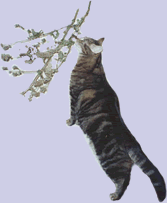 |
 The
Pit Bull is known to have a bad reputation: The
Pit Bull is known to have a bad reputation:
even here in beautiful New Hampshire and nearby
Maine. Here is a site where you can access excellent
breed information ... Is it a Pit Bull? A Bulldog? An
American Pit Bull Terrier? What is an American Staffordshire
Terrier? ... read about their history ... how the early
colonists imported them right along with their other
worldly treasures ... and learn the Top 15 Tips for
being a responsible dog owner.
TOP
 Before
you buy that puppy... Before
you buy that puppy...
ASK A DOG BREEDER THESE QUESTIONS:
Poor-quality purebreds are everywhere: Vicious golden
retrievers, crippled German shepherds and deaf Dalmatians
-- virtually every breed has some kind of genetic problem
that reputable, knowledgeable breeders are working to
eliminate.
Defective dogs most often come from two kinds of breeders:
the clueless or the careless. The first group is blissfully
ignorant of the potential for congenital problems and
the importance of socialization; the second group knows
full well and could not care less.
You can get a great pet and a great deal by working
with a shelter or rescue group. But if you simply must
have a purebred puppy, here are some questions to ask
a breeder.
What are the congenital defects in this breed? The breeder
who says "none" or "I don't know" is to be avoided.
That's a person who's not screening for what she doesn't
know about, and you don't want to pay the price for
her ignorance.
A good breeder tells you every remotely possible problem
in the breed, from droopy eyelids to deafness to epilepsy.
What steps have you taken to decrease defects in your
dogs? You want to hear words like "screened" and "tested"
and "certified".
In breeds with the potential for hip dysplasia - that's
almost every large breed -- look for PennHIP or Orthopedic
Foundation for Animals certification. These are expert,
unbiased evaluators who know exactly what to look for.
Insist on documentation on both parents. And their parents,
too.
Do you have the parents on site? May I see them? This
is a bit of a trick question. You should always be able
to see the mother -- unless she died giving birth --
but reputable breeders often don't have the father on
hand. That's because the best match for any particular
dog may be owned by another breeder, and the female
was sent away for breeding.
As for the mother, she may be a little anxious with
strangers around her puppies, but on her own you want
to see a well socialized, calm and well mannered dog.
So, too, should be the rest of the breeder's dogs. If
you don't like the temperaments of a breeder's grown
dogs, what makes you think you'll get a good temperament
in one of the puppies?
What are the good and bad points of the parents, and
what titles do they have? You may be looking for a pet
quality purebred, but you still want to buy from someone
who knows what top quality examples of the breed are
-- and uses such animals in a breeding program. You
want to see show and working titles all over that pedigree.
It doesn't matter if you go home and throw that fine
pedigree in a drawer. Recent titles on both sides of
a pedigree are the sign of a breeder who's making a
good-faith effort to produce healthy dogs who conform
to the breed standard.
Where were these puppies raised? How have you socialized
them? "In the house" is the best answer to the first
question. You want a puppy who knows what the dishwasher
sounds like, whom you don't have to peel off the ceiling
when a pan drops, who has set a paw on linoleum, carpet
and tile.
Environmental socialization is important, but so, too,
is the intentional kind. The best breeders make sure
puppies have been handled by adults of both genders
and by children.
What guarantees do you provide? You want to see a con-
tract explaining the breeder's responsibilities should
the puppy develop a congenital ailment. In most cases,
such contracts state either replacement with a new puppy
or refunding of your purchase price.
The contract also states your responsibilities, such
as neutering your pet. You may also be required to return
the dog to the breeder if you can no longer keep him.
Such language is the sign of a concerned and responsible
breeder.
Read and discuss the paperwork with the breeder. The
best breeders offer contracts that protect not only
the buyer and seller, but also the most vulnerable part
of the transaction: the puppy.
TOP

"THE MIRACLE
OF LIFE"
"Come
quick, come quick," their mother said,
"The time is getting near."
She feels that when the kittens come,
The children should be here.
She
told them that a big orange Tom
Took "Kitty" as his wife.
"It's wonderful, a gift from God,
The miracle of life."
At
half a year, young "Kitty"
Feels too painful and too scared
To appreciate six miracles,
Blind-eyed and yellow haired.
But
she knows these lives depend on her
And nature tells her how.
And as she cleans them, children ask,
"Mom, can we go now?"
But
now and then for six more weeks
The children visit her
To play with six new magic toys
Made of life and fur.
The
six weeks pass, the newness gone,
And new homes yet unfound,
Mom bundles up six miracles
And takes them to the pound.
Where
lovingly, with gentle hands,
And no tears left to cry,
The shelter workers kiss them once,
and take them off to die.
And
"Momma Kitty" now she's called
Mourns her loss and then,
She's put outside, and of course,
She's pregnant once again.
Dad
tells "Kitty," "STOP THIS NOW,
Or you won't live here long!
But deep inside of Momma Cat,
This time something's wrong.
Too young, too small, too often bred,
Now nature's gone awry,
Momma Kitty feels it too,
And she crawls off to die.
She
too is freed from this cruel world,
And from her time of strife.
How harsh the truth, how high the price,
This "Miracle of Life?"
--By
Barry Taylor, DVM
 |
 Here's everything you've ever wanted to know about catnip
but were afraid to ask. You're going to be an expert
on the subject after this - a virtual "catnip-ologist!"
Here's everything you've ever wanted to know about catnip
but were afraid to ask. You're going to be an expert
on the subject after this - a virtual "catnip-ologist!"
Here's the story of this "mysterious" stuff in a nutshell:
Catnip, also known as catmint, catrup and catwort, is
a plant from the mint family. It is found native from
the eastern Mediterranean region to the eastern Himalayas
and has become widely introduced in North America -
and can be found even as far north as Alaska.
The generic name for catnip, Nepeta, is named after
the town Nepete, Italy, where it was once largely cultivated.
Catnip was first grown for cats by the classical Greeks
and Romans, and by 1265 it was a familiar herb of kitchen
gardens in England. During the early medieval period
the leaves and young shoots were used as a seasoning.
In 15th century England, catnip leaves were used for
rubbing meats before cooking, and also sprinkled in
mixed green salads. Before modern Chinese tea became
widely available, catnip tea was frequently consumed
for its assumed calming effect.
Catnip, of course, is best known for inducing euphoric
responses in cats. Any branches or leaves that have
been bruised or broken will emit the active ingredient,
hepetalactone, which affects the brain of a sensitive
kitty by "turning them on" just as some drugs affect
people. The response is a 10 minute frenzy of pleasure:
They lick, chew and claw the catnip, rub their heads
and bodies against it, and roll in it in ectasy. They
will purr, meow, and jump in apparent sheer delight.
(Oh, how undignified for some!)
While most cats are affected to some degree by catnip,
not all are "nipaholics". About 20% of cats seem to
be "immune" and do not respond to it at all, and whether
or not your cat will respond has to do solely with genetics.
Also, kittens less than 2 months old usually do not
react to it and some cats do not react until after 3
months of age.
So if your cat is older than 3 months and does not have
the slightest interest in those catnip mouse toys you
spent a fortune on for Christmas, don't be disappointed.
Just accept the fact that it's just not in her genes!
Pass the toys on to a friend with a catnip sensitive
cat for their enjoyment.
From 12 October 2001 CATNIPS
TOP
|




